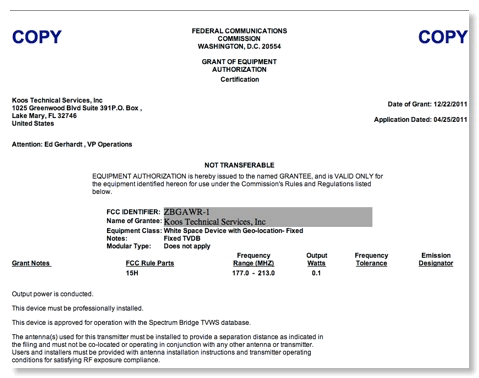TV Whitespace Progress
Today, the Federal Communications Commission issued a Public Notice announcing that the Office of Engineering and Technology (OET) has approved Spectrum Bridge Inc.’s television white spaces database system, which may provide service to devices beginning January 26, 2012. OET has also approved a device by Koos Technical Services, Inc. (KTS) as the first product allowed to operate on an unlicensed basis on unused frequencies in the TV bands. The KTS device will operate in conjunction with the Spectrum Bridge TV band database.
The database announcement says the database approval is effective January 26, 2012. NAB reported some problems during testing and asked for both more testing and another round of comments. FCC rejected the need for more comments but required that the problems identified to date be fixed. However, the initial implementation of the database will be limited to “ to the Wilmington, NC market, specifically to the city of Wilmington and New Hanover County, NC” due to problems with the FCC registration system for nonbroadcaster high density wireless microphone usage sites such as concerts. Your blogger has serious doubts whether the FCC provision for registering these wireless miss will be practical. Time will tell.

Above is the first equipment authorization approval granted to Florida’s Koos Technical Services, a firm that seems to have some partnership with Spectrum Bridge. While the Commission’s Rules do not forbid this type of relationship, one wonders if anyone ever thought about it from the policy viewpoint.
The FCC grant is surprising in that the approved spectrum is not UHF, but rather 177-213 MHz in the upper VHF band. This is the middle of channel 7 to the middle of channel 13. The device’s manual states that “it is designed to provide a reliable wireless connection for digital communication in selected TV bands in the 174 – 216 MHz (VHF) or 470 - 698 MHz (UHF) frequency ranges.” The manual also states the power amplifier “provides up to 1 Watt (30 dBm) of RF output power” - but the approved power limit is 0.1 Watt. The manual states the data rate is “1.5 or 3.1 Mb/s” with a 6 MHz channel bandwidth. Indeed the test reports KTS submitted to FCC repeatedly mention “Transmit power 25 dBm” or 0.316 W, yet the authorized power is 0.1 W. So it is clear that the parameters that were approved are not the ones in the original submittal to FCC.
Perhaps KTS had to back off its intended performance to meet FCC emission limits. Previously, several mainstream manufacturers complained to FCC that they could not meet the out-of-band emission requirements in this band with off-the-shelf equipment designs. However, MSS client Adaptrum demonstrated to FCC in a March 2011 filing that it could comply with the OOBE limits.
Congratulations to Spectrum Bridge and KTS on these first approvals. We hope there will be many more soon.
UPDATE
Andrew Mancone, Director of Sales and Marketing at KTS Wireless posted this clarification to Linkedin’s Spectrum Experts group:
Unfortunately, that paragraph in the December 22nd FCC notice caused a bit of confusion. The project in Wilmington has approval to move forward but our certification is finalized and valid starting January 26th, 2012.
Rumor has it that there are some wireless microphone channel optimization efforts underway and the administrative cleanup will take until the 26th of January. Therefore, the staggered start.
Fear not, certified devices are now here and implementation plans can move forward.



![Validate my RSS feed [Valid RSS]](valid-rss-rogers.png)

